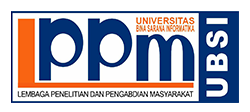ANALISIS AISAS MODEL TERHADAP “BTS EFFECT” SEBAGAI BRAND AMBASSADOR DAN INFLUENCER
Abstract
Keywords
Full Text:
PDFReferences
Brown, D., & Hayes, N. (2008). Influencer Marketing : Who Really Influences Your Customers?. Oxford: Elsevier.
Doucett, E. (2008). Creating Your Library Brand, Communicating Your Relevance and Value to Your Patrons. Chicago: American Library Association (E-books).
Gaied, A., & Rached, K. (2010). The Persuasive Effectiveness of Famous and Non Famous Endorsers in Advertising. IBIMA Business Review, 2010, 1–13. https://doi.org/10.5171/2010.474771
Hapsari, P. D. (2016). ANALISIS AISAS MODEL TERHADAP PRODUCT PLACEMENT DALAM FILM INDONESIA Studi Kasus : Brand Kuliner di Film Ada Apa Dengan Cinta 2. 12(2), 69–81.
Kamins, M. A. (1990). An Investigation into the ‘Match-Up’ Hypothesis in Celebrity Advertising: When Beauty May be Only Skin Deep. Journal of Advertising, 19(1), 4–13.
Kotler, P. (2000). Manajemen Pemasaran. Jakarta: Prenhallindo.
Kotler, P. (2003). Marketing Management International. New Jersey: Prentice Hall.
Kotler, P., & Armstrong, G. (2015). Principles of Marketing (Edisi 12). Jakarta: Erlangga.
Kotler, P., & Keller, K. L. (2008). Manajemen Pemasaran (Jilid 1). Jakarta: Erlangga.
Lea-Greenwood, G. (2012). Fashion Marketing Communications E-book. USA: Wiley.
Misra, S., & Beatty, S. E. (1990). Celebrity spokesperson and brand congruence: An assessment of recall and affect. Journal of Business Research, 21(2), 159–173.
Ohanian, R. (1991). The Impact of Celebrity Spokespersons’ Perceived Image on Consumers Intention to Purchase. Journal of Advertising, 31(1), 46–54.
Rex, M. (1997). Source Expertise and Attractiveness of Celebrity Endorsement: A Literature Review. Cyber Journal of Sport Marketing.
Royan, F. M. (2004). Marketing Celebrities. Jakarta: Elex Media Komputindo.
Shimp, T. A. (2003). Periklanan Promosi (Jilid 1). Jakarta: Erlangga.
Stafford, M. R., Stafford, T. F., & Day, E. (2002). A Contingency Approach: The Effects of Spokesperson Type and Service Type on Service Advertising Perceptions. Journal of Advertising, 31(2), 17–35.
Sugiyama, Kotaro, & Andree. (2011). The Dentsu Way. United States: Dentsu Inc.
Sumarwan, U. (2003). Perilaku Konsumen. Jakarta: Ghalia Indonesia.
Sunyoto, D. (2012). Dasar-dasar Manajemen Pemasaran. Yogyakarta: CAPS.
DOI: https://doi.org/10.31294/jkom.v11i2.7906
| Index by: | ||








|
||
| E-ISSN: 2579-3292 | ||

 https://road.issn.org/sites/all/themes/customroad/img/road-issn.png
https://road.issn.org/sites/all/themes/customroad/img/road-issn.png
|
||
Dipublikasikan oleh LPPM Universitas Bina Sarana InformatikaJl. Kramat Raya No.98, Kwitang, Kec. Senen, Kota Jakarta Pusat, DKI Jakarta 10450
|








